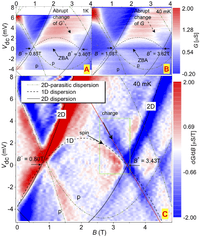Charges

Charge is usually thought of as a property of matter that is responsible for electrical phenomena, existing in a positive or negative form.
Theoretical charges
Def. "the quantity of unbalanced positive or negative ions in or on an object; measured in coulombs"[1] is called charge, or electric charge.
Chargons
Def. "a quasiparticle produced as a result of electron spin-charge separation"[2] is called a chargon.
A chargon possesses the charge of an electron without a spin.
A spinon, in turn, possesses the spin of an electron without charge. The suggestion is that an elementary particle such as a positron may consist of at least two parts: spin and charge.
In the figure at the top of the page "the 1D parabola tracks the spin excitation (spinon)."[3]
Def. a "quasiparticle, corresponding to the orbital energy of an electron, which can result from an electron apparently ‘splitting’ under certain conditions"[4] is called an orbiton.
Both an orbiton and a spinon are kinetic or kinematic concepts applied to an electron.
Def. "a discrete particle having zero rest mass, no electric charge, and an indefinitely long lifetime"[5] is called a photon.
An electron may be thought of as a stable subatomic particle with a charge of negative one.
Research
Hypothesis:
- Electron-positron annihilation is the casting off of the spinons and the generation of two identical photons, or 0.511 MeV γ rays, that are out of phase with each other.
Control groups

The findings demonstrate a statistically systematic change from the status quo or the control group.
“In the design of experiments, treatments [or special properties or characteristics] are applied to [or observed in] experimental units in the treatment group(s).[6] In comparative experiments, members of the complementary group, the control group, receive either no treatment or a standard treatment.[7]"[8]
Proof of concept
Def. a “short and/or incomplete realization of a certain method or idea to demonstrate its feasibility"[9] is called a proof of concept.
Def. evidence that demonstrates that a concept is possible is called proof of concept.
The proof-of-concept structure consists of
- background,
- procedures,
- findings, and
- interpretation.[10]
See also
References
- ↑ "electric charge, In: Wiktionary". San Francisco, California: Wikimedia Foundation, Inc. 24 July 2015. Retrieved 2015-08-08.
- ↑ Xhienne (30 April 2012). "chargon, In: Wiktionary". San Francisco, California: Wikimedia Foundation, Inc. Retrieved 2015-08-08.
- ↑ Y. Jompol, C. J. B. Ford, J. P. Griffiths, I. Farrer, G. A. C. Jones, D. Anderson, D. A. Ritchie, T. W. Silk and A. J. Schofield (July 2009). "Probing spin-charge separation in a Tomonaga-Luttinger liquid". Science 325 (5940): 597-601. doi:10.1126/science.1171769. http://arxiv.org/pdf/1002.2782v1.pdf. Retrieved 2015-08-08.
- ↑ Widsith (19 April 2012). "orbiton, In: Wiktionary". San Francisco, California: Wikimedia Foundation, Inc. Retrieved 2015-08-08.
- ↑ Poccil (18 October 2004). "photon, In: Wiktionary". San Francisco, California: Wikimedia Foundation, Inc. Retrieved 2015-08-08.
- ↑ Klaus Hinkelmann, Oscar Kempthorne (2008). Design and Analysis of Experiments, Volume I: Introduction to Experimental Design (2nd ed.). Wiley. ISBN 978-0-471-72756-9. http://books.google.com/?id=T3wWj2kVYZgC&printsec=frontcover.
- ↑ R. A. Bailey (2008). Design of comparative experiments. Cambridge University Press. ISBN 978-0-521-68357-9. http://www.cambridge.org/uk/catalogue/catalogue.asp?isbn=9780521683579.
- ↑ "Treatment and control groups, In: Wikipedia". San Francisco, California: Wikimedia Foundation, Inc. May 18, 2012. Retrieved 2012-05-31.
- ↑ "proof of concept, In: Wiktionary". San Francisco, California: Wikimedia Foundation, Inc. November 10, 2012. Retrieved 2013-01-13.
- ↑ Ginger Lehrman and Ian B Hogue, Sarah Palmer, Cheryl Jennings, Celsa A Spina, Ann Wiegand, Alan L Landay, Robert W Coombs, Douglas D Richman, John W Mellors, John M Coffin, Ronald J Bosch, David M Margolis (August 13, 2005). "Depletion of latent HIV-1 infection in vivo: a proof-of-concept study". Lancet 366 (9485): 549-55. doi:10.1016/S0140-6736(05)67098-5. http://www.ncbi.nlm.nih.gov/pmc/articles/PMC1894952/. Retrieved 2012-05-09.
External links
![]() This is a research project at http://en.wikiversity.org
This is a research project at http://en.wikiversity.org
| |
Development status: this resource is experimental in nature. |
| |
Educational level: this is a research resource. |
| |
Resource type: this resource is an article. |
| |
Resource type: this resource contains a lecture or lecture notes. |
| |
Subject classification: this is a physics resource . |